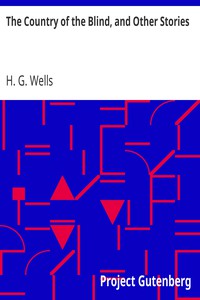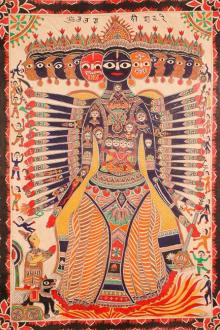The Country of the Blind, and Other Stories, H. G. Wells [top 10 books of all time TXT] 📗

- Author: H. G. Wells
Book online «The Country of the Blind, and Other Stories, H. G. Wells [top 10 books of all time TXT] 📗». Author H. G. Wells
Such were the first general impressions of Mr. Cave. The story is curiously direct and circumstantial. From the outset, when the valley first flashed momentarily on his senses, his imagination was strangely affected, and as he began to appreciate the details of the scene he saw, his wonder rose to the point of a passion. He went about his business listless and distraught, thinking only of the time when he should be able to return to his watching. And then a few weeks after his first sight of the valley came the two customers, the stress and excitement of their offer, and the narrow escape of the crystal from sale, as I have already told.
Now, while the thing was Mr. Cave's secret, it remained a mere wonder, a thing to creep to covertly and peep at, as a child might peep upon a forbidden garden. But Mr. Wace has, for a young scientific investigator, a particularly lucid and consecutive habit of mind. Directly the crystal and its story came to him, and he had satisfied himself, by seeing the phosphorescence with his own eyes, that there really was a certain evidence for Mr. Cave's statements, he proceeded to develop the matter systematically. Mr. Cave was only too eager to come and feast his eyes on this wonderland he saw, and he came every night from half-past eight until half-past ten, and sometimes, in Mr. Wace's absence, during the day. On Sunday afternoons, also, he came. From the outset Mr. Wace made copious notes, and it was due to his scientific method that the relation between the direction from which the initiating ray entered the crystal and the orientation of the picture were proved. And, by covering the crystal in a box perforated only with a small aperture to admit the exciting ray, and by substituting black holland for his buff blinds, he greatly improved the conditions of the observations; so that in a little while they were able to survey the valley in any direction they desired.
So having cleared the way, we may give a brief account of this visionary world within the crystal. The things were in all cases seen by Mr. Cave, and the method of working was invariably for him to watch the crystal and report what he saw, while Mr. Wace (who as a science student had learnt the trick of writing in the dark) wrote a brief note of his report. When the crystal faded, it was put into its box in the proper position and the electric light turned on. Mr. Wace asked questions, and suggested observations to clear up difficult points. Nothing, indeed, could have been less visionary and more matter-of-fact.
The attention of Mr. Cave had been speedily directed to the bird-like creatures he had seen so abundantly present in each of his earlier visions. His first impression was soon corrected, and he considered for a time that they might represent a diurnal species of bat. Then he thought, grotesquely enough, that they might be cherubs. Their heads were round and curiously human, and it was the eyes of one of them that had so startled him on his second observation. They had broad, silvery wings, not feathered, but glistening almost as brilliantly as new-killed fish and with the same subtle play of colour, and these wings were not built on the plan of bird-wing or bat, Mr. Wace learned, but supported by curved ribs radiating from the body. (A sort of butterfly wing with curved ribs seems best to express their appearance.) The body was small, but fitted with two bunches of prehensile organs, like long tentacles, immediately under the mouth. Incredible as it appeared to Mr. Wace, the persuasion at last became irresistible that it was these creatures which owned the great quasi-human buildings and the magnificent garden that made the broad valley so splendid. And Mr. Cave perceived that the buildings, with other peculiarities, had no doors, but that the great circular windows, which opened freely, gave the creatures egress and entrance. They would alight upon their tentacles, fold their wings to a smallness almost rod-like, and hop into the interior. But among them was a multitude of smaller-winged creatures, like great dragon-flies and moths and flying beetles, and across the greensward brilliantly-coloured gigantic ground-beetles crawled lazily to and fro. Moreover, on the causeways and terraces, large-headed creatures similar to the greater winged flies, but wingless, were visible, hopping busily upon their hand-like tangle of tentacles.
Allusion has already been made to the glittering objects upon masts that stood upon the terrace of the nearer building. It dawned upon Mr. Cave, after regarding one of these masts very fixedly on one particularly vivid day that the glittering object there was a crystal exactly like that into which he peered. And a still more careful scrutiny convinced him that each one in a vista of nearly twenty carried a similar object.
Occasionally one of the large flying creatures would flutter up to one, and folding its wings and coiling a number of its tentacles about the mast, would regard the crystal fixedly for a space,—sometimes for as long as fifteen minutes. And a series of observations, made at the suggestion of Mr. Wace, convinced both watchers that, so far as this visionary world was concerned, the crystal into which they peered actually stood at the summit of the end-most mast on the terrace, and that on one occasion at least one of these inhabitants of this other world had looked into Mr. Cave's face while he was making these observations.
So much for the essential facts of this very singular story. Unless we dismiss it all as the ingenious fabrication of Mr. Wace, we have to believe one of two things: either that Mr. Cave's crystal was in two worlds at once, and that while it was carried about in one, it remained stationary in the other, which seems altogether absurd; or else that it had some peculiar relation of sympathy with another and exactly similar crystal in this other world, so that what was seen in the interior of the one in this world was, under suitable conditions, visible to an observer in the corresponding crystal in the other world; and vice versa. At present, indeed, we do not know of any way in which two crystals could so come en rapport, but nowadays we know enough to understand that the thing is not altogether impossible. This view of the crystals as en rapport was the supposition that occurred to Mr. Wace, and to me at least it seems extremely plausible...
And where was this other world? On this, also, the alert intelligence of Mr. Wace speedily threw light. After sunset, the sky darkened rapidly— there was a very brief twilight interval indeed—and the stars shone out. They were recognisably the same as those we see, arranged in the same constellations. Mr. Cave recognised the Bear, the Pleiades, Aldebaran, and Sirius; so that the other world must be somewhere in the solar system, and, at the utmost, only a few hundreds of millions of miles from our own. Following up this clue, Mr. Wace learned that the midnight sky was a darker blue even than our midwinter sky, and that the sun seemed a little smaller. And there were two small moons! "like our moon but smaller, and quite differently marked," one of which moved so rapidly that its motion was clearly visible as one regarded it. These moons were never high in the sky, but vanished as they rose: that is, every time they revolved they were eclipsed because they were so near their primary planet. And all this answers quite completely, although Mr. Cave did not know it, to what must be the condition of things on Mars.
Indeed, it seems an exceedingly plausible conclusion that peering into this crystal Mr. Cave did actually see the planet Mars and its inhabitants.





Comments (0)